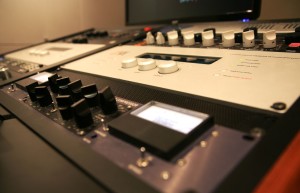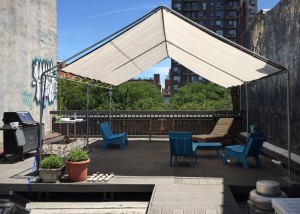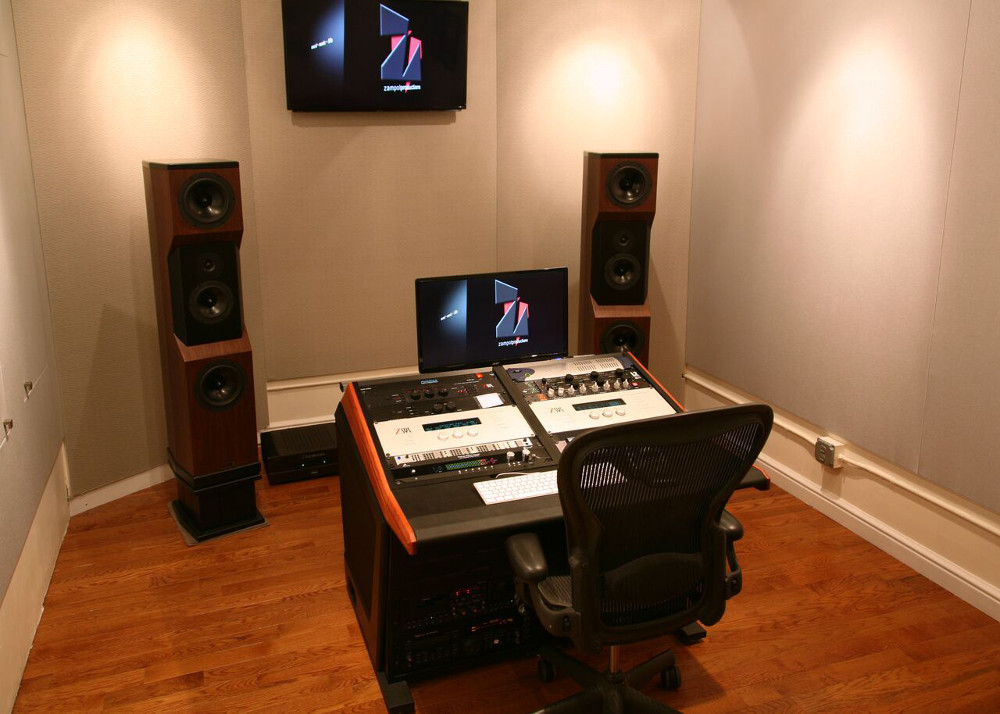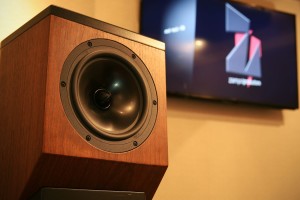Zampol Productions: Mastering Moves On Up to the Lower East Side
Milestones are abounding for Oscar Zambrano.
This New York City mastering engineer is smiling because he’s just completed his 100th project of the year in mid-July, a new album for singer-songwriter Jo Kroger. But that’s not the only magic number that’s working for him now.
Zambrano is also hoping that the third time’s a charm when it comes to locations for his mastering practice – and there’s every reason to believe he’s chosen wisely. His freshly minted room is part of the quietly successful complex called 2nd Story Sound, a lower East side audio facility where personalities and service offerings are converging perfectly.
After having mastering suites in the former Sorcerer Sound space, and Crushing Music before that, Zambrano’s new address seems like a dream come true. There is a steady flow of artists, engineers, producers, and projects coming in and out of the building – a seemingly long-lost set of conditions conducive to both commerce and social well-being.
Zambrano, whose credits include Loudon Wainwright III, Sufjan Stevens, Eldar Djangirov, and the new cast recording for An American in Paris, is glad to have found such an optimal situation 12 years into his career. “It’s a good fit for me because the upgrade was really nice – it’s a bigger mastering room, plus a lounge and a kitchen,” he says. “But the main thing is the vibe that we have. Other musicians and engineers are around – that’s something that doesn’t happen much anymore. Everyone is very friendly and makes a point to hang. Now they have a mastering facility here and they can do that in-house. In turn, I can also hire them for recording.”
Making a New Mastering Room
Enter into Zambrano’s inner sanctum, which is officially known as Zampol Productions, and a highly accurate listening environment is assured.
The room was designed and built by Zambrano and MSR Chief Engineer Brad Leigh, creating a space that’s as comfortable as it is technically accurate. Through a process of careful tuning and acoustical treatment, Zambrano achieved the mastering suite he was looking – and listening — for.
“I definitely wanted an honest room,” he explains. “I wanted the high end a little hyped, because I’m not a fan of brittle sounds, so I didn’t want the high end to be hidden. In a lot of project studios now, the big problem is the low end, so I wanted to address that as well.
“Brad, Matt Azevedo from Acentech and I shot the room, naturally, but we wound up using our ears more than technical specs. When a mastering engineer moves, the big thing is getting used to the room. If you really know your speakers well, then any issues you become aware of you know are with the room, and you can make adjustments accordingly.”

Zambrano’s console features z-systems, Dangerous, and Manley among the carefully curated selection. (Photo Credit: Lauren Kuei)
Inside the sweet spot, Zambrano has deployed a relatively tight gear selection to apply his craft. An Antelope Eclipse Mastering AD/DA Converter and Dual 64-bit Acoustically Focused Master Clock is at the center of things. Outboard includes a Manley Vari Mu Limiter Compressor (mastering version with TBar Mod); Z-Systems zq-1 Stereo Digital Parametric Equalizer, z-CL6 Six Channel Mastering Dynamic Processor, z-Q6 Six Channel Mastering Equalizer, and Z-16 Digital Detangler; a Dangerous BAX EQ; and Waves L2 hardware unit.
Zambrano likes to engineer as well, and conveniently there is an assortment of mic pre’s and microphones available across the hall.
Inside the box, Zambrano’s collection includes Waves Platinum plugins; Izotope RX Advanced, Ozone 5 and 6; and every plugin that Slate makes. At the helm are Pro Tools 10 HD, Sound Blade SE, Sonoris DDP Creator, and a Sonoris custom DDP Player.
To make it all audible, Zambrano depends on a pair of custom-made DX2 Tyler Acoustics speakers, powered by Bryston SST 4 amps, connected with custom speaker cable. “I explained what the room is like to Tyler, and he custom made a pair of DX2’s for me,” recalls Zambrano. “He said, ‘If you don’t like it, send them back and will try something else.’ He built them, shipped them over six weeks later, and he said to give the system 200 hours of play before everything settles in. I was always a bit skeptical about the burn in but was amazed at how nicely everything came together after a few hundred hours. It sounds really good.”
Zambrano’s Dangerous BAX EQ was a lucky find. “I got the Bax EQ when a friend of mine was selling it,” he says. “I love how transparent it is, and what you can do with it, without it sounding harsh. I love the high-end – you can boost it 1.5 dB at 7k, which is a lot in mastering, and it sounds really nice, whereas other EQ’s would sound hard and brittle. The other thing I like about it is how it cleans up the low shelf. It’s very transparent in the way it does stuff, but it has a sonic footprint, and I’m using it more than I thought I would.”
Proof that the setup is working comes from the most important source – his clients. “When they come in, they say, ‘It’s great – the mix sounds the way I expected,’” Zambrano points out. “There are no surprises. A few weeks ago, Chris Parks from Kaleidoscope came out for a mastering session, and there were no recalls. Chris is someone I trust sonically, I know he’s going to be honest with me. It was great to get that feedback.
“The way everything is set up in here, I’m feeling more comfortable with everything. The feedback from the engineers are always what I’m most concerned with, because the artist always just says, ‘It’s louder – it’s awesome!’”
Career Pivot
Interestingly, Zambrano never set out to be a mastering engineer.
But while he was a student at Berklee College of Music, he interned at a Boston area mastering facility called M Works. Soon, he was recommended for an open position assisting the great Bob Ludwig in Portland, Maine. Zambrano passed Ludwig’s grueling four-hour listening test and was offered a job, but made the hard decision to opt for a gig at Sound On Sound in New York City, which he thought would ultimately offer more upward mobility.
Once he arrived in NYC Zambrano was surprised to find himself almost immediately in demand.
“Because of all this, my friends were like, ‘Oscar knows mastering and we don’t,” — that’s how it started,” he laughs. “I kind of didn’t want to do it at first, because in my mind mastering is like the guru thing – you need the experience, you need the ears. You settle into it later on. To be telling people that I’m a mastering engineer at age 22 felt kind of ridiculous.
“But I discovered the art of it. I started to really like it, I did it professionally, and my first credit on AllMusic was ‘mastering engineer.’ I was like NOOOOOOOOOO , but now I really like it. Today about 85% of my time spent mastering, but I also do some studio engineering. In addition, I do some postproduction for the Spanish-language market – it’s fun, it keeps my chops up, and I get to do a little mixing.”
At Your Service
Now that he’s got plenty of experience being in business, Zambrano has a firm sense of how music production is evolving – and how to evolve his own practice in turn.
“The first thing that I’m assuming, especially now, is that the people have gone over their mixes like crazy, because they can,” says Zambrano. “There is almost no recall of the boards anymore, and people have quite possibly done it in their house or project studio. So my first question is, ‘Are you happy with the mixes?’ If you are, I won’t do too much. I’ll keep it at a competitive level, because of the loudness wars, although loud isn’t necessarily better.”
The personal touch is also important to him. “The other thing is I spend some time with the artist, talking to them and trying to get to know them a little bit. I’ll discuss whether they want to do mastering for iTunes, is it worth the cost to them?

Extra headroom — the roof deck is an amenity few mastering facilities can match. (Photo Credit: Lauren Kuei)
“I especially want clients to not be intimidated by the mastering process. My attended sessions tend to go long, because I want the client to know they can ask any questions they want, without looking at the clock. I don’t charge per hour, I charge per song, so they can sit in my chair, and I can ask them, ‘Are you sure?’
“I have them bring in albums that they like, so they can listen and know the room. I also have them bring in headphones. They’ll say, ‘They’re real shitty,’ but that’s what they listen to all the time, right? Yes, so let’s listen to them.”
Along the way, Zambrano is careful to keep his eyes on the prize. “Then I try to bring out the best of the album,” he says simply. “I want the mixes sound as good as possible on all types of speakers.”
Intentionally International
An advantage that Zambrano and his business partner, Jorge Castellanos, have in growing Zampol Productions is their worldview. Both born and raised in Mexico they understand how to develop an international clientele. Check out Zampol’s list of credits, and you’ll see artists from Taiwan, Japan, Lebanon, Turkey, Malaysia, Korea, South America, Argentina, Brazil, and Mexico, as well as from Europe and the United States.
“Mexico’s a big place for Latin American music – everyone wants to make it in Mexico, and word of mouth helps me a lot there,” he notes. “The other sessions that I get from Europe, the Middle East and Asia, are happening because every time I travel I try to take a day or two to meet people. Something always comes out of that: It’s someone new for them, and they’re excited because of the NYC connection.”
No matter where the client comes from, Zambrano’s objective always comes back to their comfort level. In a service industry like mastering, he believes that everything about the process should be transparent.
“Growing the business is just about making people feel comfortable,” says Zambrano. “I’ve been in other studios where they kept that whole mystical thing going – as a client I would feel intimidated by that. So I want them to feel not like a client, but a friend. I want them to be honest with me. Mastering is a black art, but it’s not that black. It’s not that mystical.
“So you help the clients to understand what mastering is, and why you need it: You can’t do it at your house because it’s not an accurate enough room, and you can’t be approved by Apple for mastered for iTunes. You also need another person who isn’t you to check the mixes – they need to be listened to in a different space, and you need to rest your ears.”
The way Oscar Zambrano sees it, mastering isn’t about making the music louder and brighter. Instead, the biggest benefit of all is what another person with fresh ears can bring to the project.
“People are beginning to appreciate that,” he observes. “They say, ‘Send it out to mastering and they’ll tell us if something’s wrong.’ Then it’s up to the mastering engineer to listen in advance, and send back some notes — I’m all into that. I’m open to having the best project possible, even if it takes more time.”
— David Weiss
Please note: When you buy products through links on this page, we may earn an affiliate commission.









